Battery
Back to: WIS 54.10 Battery, Power Supply, Voltage Converter
Description - Battery
The W220 S Class only has one main battery. Some other M-B models have a secondary or auxiliary battery which is used to maintain the electronics whilst cranking the engine. This arrangement eliminates the need to reset various ECUs after removing or changing the main battery. A technique may be employed to maintain a 12V supply on the ECUs when replacing the battery.
Edit required.
Location - Battery
The battery is located on the right side of the trunk under the battery cover (1).
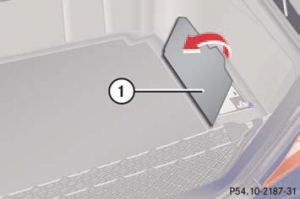
The positive (+) terminal is marked (2) and the negative (- or earth or ground) terminal (3) in the next diagram.
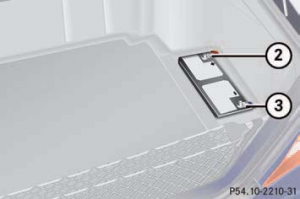
Specification - Battery
Operators manual specifies 12V/95 Ah. Recommended AGM 100 Ah.
Issues - Battery
- Battery not charging fully.
- Battery over charging.
- Parasitic discharge of battery.
- Battery at end of its life.
Symptoms - Battery
- A battery that is not fully charging will usually cause a Warning on the multi-function display as well as possibly cause some ECUs to malfunction. The vehicle may also be difficult to start or worse, even fail to crank at all. A common symptom is very slow remote control locking or unlocking.
- An over charging battery will possibly cause the alternator to sound very loud and may even smell hot or produce smoke. ECUs may be permanently damaged with constant voltages over 15V.
- A quiescent or parasitic drain usually shows as a flat battery after the vehicle is left standing for a considerable time, such as when the owner is on a vacation. A battery in good condition should last for several months with the vehicle locked and still start reliably at the end of that period.
- A battery at the end of its life will cause the vehicle to be difficult to start and may not crank the engine at all.
DIY Procedures - Battery
Introduction - Battery Tests
There are many battery monitoring tools available such as simple LED indicators showing good mediocre or bad battery state of charge to full electronic high performance Digital volt Meters (DVM), and clip on current measuring meters. One of the latest and most convenient is a three in one device which plugs into the 12V outlet in the cabin, and which shows the battery voltage on a digital display as well as the interior temperature and provides a convenient USB charging outlet.
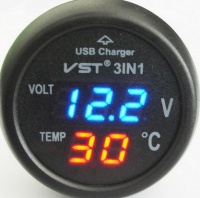
With the 12V adapter system the battery voltage may be easily monitored during normal driving conditions.
DIY Techniques - Battery Tests
A simple battery test consists of testing the following:
- Driving: After a good drive of 60 minutes or so the car battery should be fully charged and the voltmeter read at least 14.2V with the car running and the charger operating. Turn off large power consumers such as headlights for this test.
- Engine Running: You should have 13.86V across the battery terminals. Use a good Digital Voltmeter (DVM) for this test.
- Engine Off: After you leave your car over night, you should have more than 12.4V across the battery terminals. The night before, set up your voltmeter on long leads so that the boot/trunk lid can be closed and the car locked. Place the voltmeter outside the vehicle and do not activate any functions prior to taking your reading.
If you are down below 12.4V overnight, your battery is at the end of its life. Continue to use it will cost you a new alternator. W220's take lots of current (amps) to maintain the electrical systems even when you are not using your car.
Introduction - Quiescent Current or Parasitic Discharge Tests
The W220 is particularly prone to large quiescent current draw, often called parasitic current drain through it’s proliferation of electronic circuits some of which are constantly activated. Sometimes the electronic circuits can develop issues and become heavy continuous users of battery power. When the car has been locked and has fully gone to sleep (takes at least twenty minutes) the quiescent drain from the car battery must not exceed 0.05A or 50mA.
If you find that the battery is constantly going flat or the unlocking system seems to take a long time to respond, it could be that you have a low voltage battery caused by excessive quiescent current draw.
DIY Techniques - Quiescent Current or Parasitic Battery Drain Testing
It is a good idea to start with the obvious and first test the car battery charging function and the car battery itself, before embarking on the more detailed quiescent current tests. Perform the Simple Battery Tests above.
DIY High Current Sensor - Quiescent Current or Parasitic Discharge Tests
Thorough quiescent current draw can be performed by making a current sensor by manufacturing a very low resistance resistor out of a piece of coat hanger and inserting it into the main battery lead. Then a normal Digital Volt Meter (DVM) can be used to measure the voltage drop across the resistance. See this link for details:
Version 01 posted 2012-07-08: http://www.benzworld.org/forums/w220-s-class/1666913-w220-s500-measuring-quiescent-current-parasitic.html
DIY Voltage Drop Across Fuses - Quiescent Current or Parasitic Discharge Tests
It is also possible to measure the voltage drop across individual fuses using an accurate Digital Volt Mater (DVM) to give an indication of where quiescent current or parasitic current is draining the battery.
Refer to: How To Interpret and Measure the Voltage Drop Across Individual Fuses at:
DIY Clamp Sensor - Quiescent Current or Parasitic Discharge Tests
1. Close the trunk lock latch to fool the car into thinking that the trunk is closed. On some vehicles locking the latch may not be enough and you will have to improvise longer leads so that the measurements can be done with the trunk lid closed.
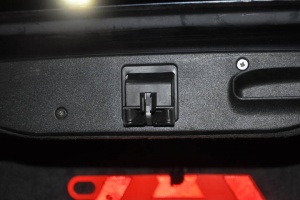
2. Lock the car. If you have keyless-go don't keep receiver close to the car otherwise car might not go to sleep.
3. Using a clamp meter which can measure small current (CEM DT-337 is one of such meters) clamp the positive or negative lead of the battery.
For some time after the car has been locked, the car may consume around 0.5A (500mA).
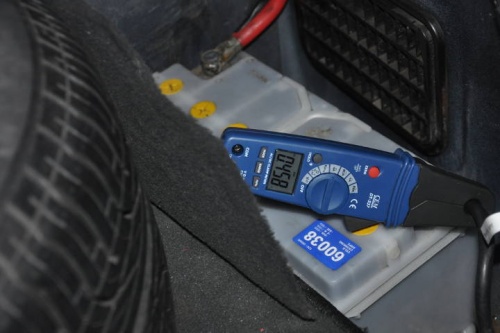
However, after half an hour, the car should fully go into sleep and should consume around 50mA. The clamp meter is not very precise when measuring very small current, therefore, anything < 100mA is probably fine.
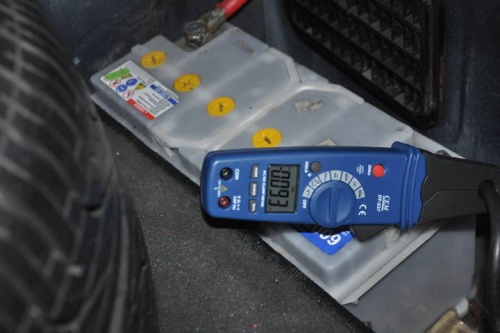
If the battery draw does not drop after half an hour, you may try to remove fuse after fuse until the draw drops. Then using fuse charts locate faulty device. Be warned this technique can require a lot of resetting ECUs afterwards.
Common Sources - Quiescent Current or Parasitic Discharge
A common source for parasitic drain is the navigation device which might not go into sleep if the DVD has got stuck or the electronics has failed.
Jump Starting - Battery
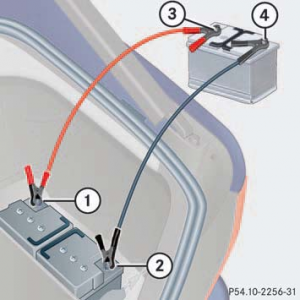
Vacation Charging - Battery
If you are out of town for over a week, you should hook up a charger to the battery and use a timer to kick it on for about one hour daily.
Charging from Inside the Engine Compartment - Battery
It is a good idea to install a charging point inside the engine compartment for easy access while vacation charging or using STAR DAS. (M-Bs after about 2006 have such charging ports fitted at the factory.)
DIY - Charging from Inside the Engine Compartment
- Remove the lid from the Right (Passenger side US, Drivers side UK) fuse box.
- Connect the negative lead from the charger to the earth point just in front of the fuse box (or any good earth).
- Connect the positive lead from the charger to fuse f33, 40A, that one runs air conditioner and blower motor and is constantly live (at 12V).
- It may be too difficult to connect to the terminal on fuse f33, 40A. If so get a spare 40A fuse and solder an extension lug onto one of the terminals. You may need a couple of goes as the heat from the soldering iron tends to melt the plastic. Use a spare so that if you damage permanently it you will not be stranded.
References - Battery
Battery Drain Tutorial: http://www.benzworld.org/forums/attachments/w220-s-class/1305786d1422707784-2002-s500-battery-drain-slow-battery-drain-troubleshooting-diy.pdf